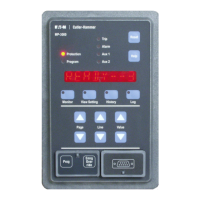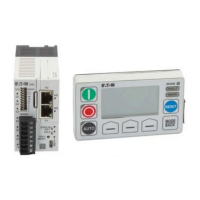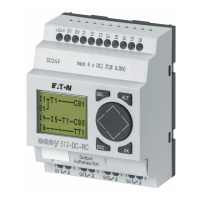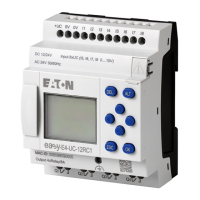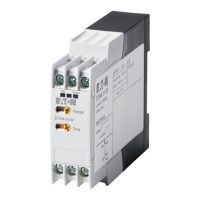IL17569
Page 8-12
Effective June, 2001
8.9.5 Breaker Failure (50BF)
The FP-5000 Breaker Failure function provides the option of local
tripping when a BFI Contact Input is detected and optional output
relay operation if local breaker failure is detected.
Table 8.6 lists the relevant setpoints to the breaker fail functions see
programming Section 5.1.
Table 8.6 Breaker Failure Settings
Parameter Range Step
Breaker Off, Int, Ext, Both
Failure
Configuration
BF Phase 0.1 to 5 x Ct 0.01 x
Current Rating, Disable Ct Rating
BF Ground 0.1 to 5 x Ct 0.01 x
Current Rating, Disable Ct Rating
Breaker 0 to 9999 Cycles 1 Cycle
Failure
Delay Time
Contact BFI
Input X
Configuration
Output Gate Rly X Trip, BF
If the Breaker Failure Configuration is programmed to Off then no
Breaker Failure function is possible. The default configuration for
Breaker Failure Configuration is Off.
If the Breaker Failure Configuration is set to “Int”; if an IOC or TOC
phase, ground, or residual trip operation occurs; if after Breaker
Failure Delay Time cycles the current is above BF Phase or BF
Ground current limits — then the Breaker Failure (BF) Trip
indication is given as well as the Breaker Failure Lockout indication.
If BF Trip is true then a programmed contact output relay will
activate. By default Output Gate Relay 3 is programmed for this
function. When the Breaker Failure Lockout is true then the FP-
5000 close command is locked out until reset. Reset is accom-
plished with a special reset command in the reset menu different
from the trip reset.
If the Breaker Failure Configuration is set to “Ext” and if a contact
input is configured to be “BFI” and is true, then a breaker failure
pickup initiates a trip operation without delay. If after Breaker Failure
Delay cycles, the current is above BF Phase or BF Ground current
limits, then the Breaker Failure (BF) Trip indication is given along
with the BF lockout indication. By default, contact input 3 is
configured to BFI. Reset is accomplished with a special reset
command in the reset menu different from the trip reset.
It can be seen that a downstream device might use the Breaker
Failure Configuration “Int” to issue a breaker failure event, and use
the “Ext” setting in an upstream breaker to immediately trip upon
downstream breaker failure.
If the Breaker Failure Configuration is set to “Both” then both “Int”
and “Ext” function operate independently as explained above.
8.9.6 Breaker State Alarm
The Breaker State Alarm reports contact disagreement if both 52a
and 52b remain in the same state for more than 30 cycles. By
default, the alarm contact output relay will close.
8.9.7 Breaker Trouble
Any of the eight contact inputs (Cin1 – Cin8) can be configured as
Breaker Trouble. Contact input 4 is so configured by default. If
external logic determines that the breaker has failed in some way
then it can activate this contact input. If this input is true and the FP-
5000 gives the command to close the breaker then the closed
breaker command will be locked out until the signal goes to the
inactive state.
8.9.8 Slow Breaker Time
If the FP-5000 is used to issue the close and open breaker signal to
the breaker, and if at least 52a or 52b is configured to a contact
input then the Slow Breaker Time Monitoring is activated. If a
breaker close command is issued from one of the FP-5000 output
relays, the state of the breaker is monitored to see how long it takes
for the 52a to activate or the 52b to deactivate. If it takes more than
40 cycles for the breaker to change to the closed state, the slow
breaker time alarm is raised. By default the alarm contact output
relay will close.
Likewise if the open command is given and the breaker takes more
than 15 line cycles to change to the open state the slow breaker time
alarm is raised. By default the alarm contact output relay will close.
8.10 Setting Up Oscillographic Data Capture
The FP-5000 can capture oscillographic waveforms based on a
number of triggers. This function is useful to capture waveform data
during faults and abnormal events for later analysis. The oscillo-
graphic data can be viewed using the Cutler-Hammer PowerNet
software package equipped with the NPWAVEFORM component.
All four voltage, and four current inputs are captured when a trigger
occurs and are available for display. The waveform data consists of
32 samples a cycle. Table 8.7 list the setpoints used for setting up the
oscillographic data waveform capture function.
Table 8.7 Waveform Capture Setpoints
Parameter Range Units
Records 4 X 64, 8 X 32, # of
16 X 16 Waveforms X
# of Cycles
Recorded
Pre-Trigger 1 – 15 Line Cycles
OSC Trigger Trip 2, dV/dI, Disable,
Logic LG6, Overwrite, Lock
Cntrl PB, Comm
The Records setpoint defines how many sets of all inputs can be
captured per the number of cycles recorded. By default, 16
waveform sets will be available with a recorded length of 16 line
cycles long. A smaller number of waveform sets can be selected
allowing for a longer recording time of 32 or 64 cycles. In all cases
each cycle of data contains 32 data points.
The Pre-Trigger setpoint defines the number of cycles captured and
recorded before the defined trigger event. The pre-trigger applies to
all waveform sets captured. By default 2 cycles will be recorded
before the trigger event, and 14 cycles after the trigger event.
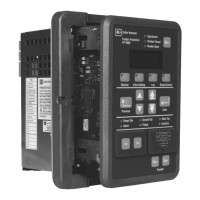
